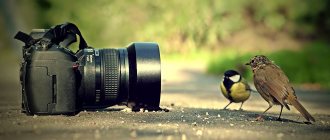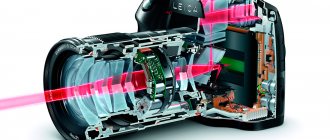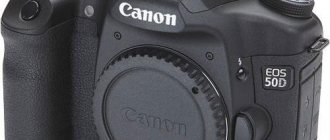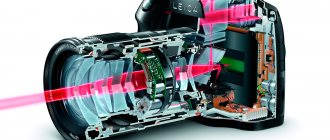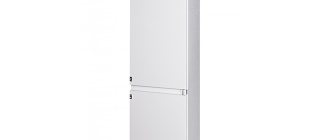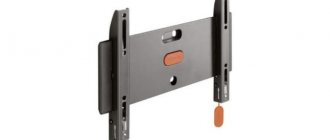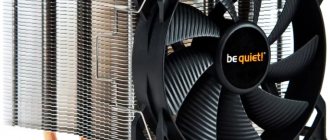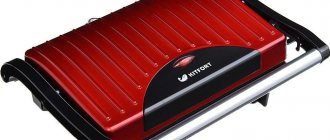Today, no one will be surprised by a new SLR camera in the hands of an inexperienced student. It has become very prestigious to have a DSLR instead of a regular digital camera. Naturally, most often in the selection process no one cares about the main parameters of the camera, the main thing is the price tag and the word SLR. Although when the need arises to purchase not for status, but for maximum functionality. The question arises: “how to choose a SLR camera?”
There are many resources on the Internet with specialized information for professional photographers, which the average user cannot understand. Therefore, the article contains all the important concepts for beginners and explains them in simple language. Well, for greater usefulness, a review of the best camera models in the category.
What is a SLR camera
To clarify, you can look into any electronic encyclopedia and find an incomprehensible set of words instead of a definition.
Translated into Russian, a DSLR can be called any representative of this segment of technology that has a mirror in its device.
Using a lens system, light penetrates the body of the camera, is reflected from the mirror prism and hits the matrix, which transmits the image to the viewfinder.
Here another unfamiliar word appears: matrix. In essence, the matrix is a semiconductor wafer on which there are ultra-sensitive cells - pixels. They take photos by capturing light waves and converting them into electromagnetic waves.
In ordinary cameras there is no mirror, as well as a lens system, that is, the light falls directly on a specially modified matrix. Naturally, when electronics are used, the image is delayed and distorted.
SLR cameras are divided into amateur and professional.
Pros of a DSLR camera
If you ask a professional photographer about the advantages of a DSLR camera, he will begin to list countless specific characteristics of the camera.
The main advantages are: long battery life without recharging, fast operating speed, clarity of images, natural (without distortion) colors, excellent performance in any lighting.
All of the above advantages are determined by the design features of the camera and depend on the performance of the filling.
How to choose the right DSLR cameras
The question is interesting, to answer it you need to find out something else: what characteristics are worth paying attention to.
The first thing you need to decide is whether the lens is important to you in the photography process or whether you can get by with the camera itself.
Glass (lens) can be different. Prices also vary. At the beginning of mastering professional photography, it is recommended to limit yourself to a basic lens or kit, as it is also called. Maybe all the delights of the camera will seem unnecessary to you and further advancement is useless. Then additional expenses can also be eliminated.
When purchasing an accessory, a beginner should look at the focal length of the mirror. 18-55 is considered optimal. It will help you photograph both distant and close objects without any problems.
Another tip: if you really want to make your life easier, then buy a DSLR without glass. And after mastering the basic principles, you will already select the appropriate equipment.
The next important parameter in a DSLR camera is the matrix. At its core, it is considered an analogue of a frame on film and is responsible for the quality of the image.
When choosing a camera, the size and resolution of the matrix are important. The optimal resolution is 10-12 megapixels. No more manufacturers needing to say nothing. But it is better to choose a larger size. The larger the area, the more beautiful the pictures will be.
In addition, you need to take into account the ISO level (sensitivity) of the matrix, that is, the level of light perception. A higher rate will make it possible to shoot in poorly lit rooms and outdoors at night.
Currently, two types of matrices are used: CDD (charge-coupled device) and CMOS (complementary metal-oxide-conductor).
The first ones are taken for quality: the level of “noise” is very low. The latter benefit in price, although the quality suffers from this: there is a lot of interference. But they think quickly and consume less battery.
Another gobbledygook in the description of the DSLR can be the speed and stabilization.
For the DSLR brother of the digital camera, stabilization helps eliminate blurry shooting, even when the photographer’s hands are shaking. The only disadvantage of such a system is that the photo is not very sharp. A similar characteristic can be found in both the camera and the lens. It will be terribly useful for beginners.
Its superior speed gives the DSLR the ability to capture action shots, whether it's a pet or a competition.
Based on the above characteristics, you can choose the one that is most convenient for you.
Of course, all this is just a theory that needs to be applied in practice, that is, in comparing real cameras. The only thing that still needs to be remembered is the desire parameters. For example, the maximum resolution in all flagship models is much higher than optimal. The reason is simple, marketing: 40 megapixels sounds better than 12.
What are the types of lenses for SLR cameras?
Most often, a DSLR camera is sold complete with a lens. This is usually a good quality universal lens with a focal length range of 18-55 millimeters. One of the significant advantages of DSLR cameras is the ability to change lenses. Over time, you can add more expensive lenses and lenses with different focal length ranges to your arsenal. There are wide-angle lenses for shooting cityscapes and interiors, telephoto lenses for shooting sports and wildlife, and many other specialty lenses.
The following are the main types of lenses:
| Lens | Focal length | Purpose |
| ultra wide angle lens | less than 18 mm | for shooting large scenes and interiors |
| wide angle lens | from 18 to 30 mm | for group photography, landscape and street photography |
| standard lens (universal) | from 30 to 70 mm | for portraits and everyday photography |
| telephoto lens | from 70 to 300 mm | for portraits and sports photography |
| super telephoto lens | more than 300 mm | for sports and wildlife photography |
Alternatively, you can buy a DSLR without a lens. Buy a camera without a lens if you already have a set of lenses or if the included lens is not suitable for your purposes (for example, for sports photography). Before purchasing, you should make sure that the camera is compatible with the lenses you have.
Rating of the best SLR cameras
Our experts have compiled a list of the best SLR cameras, the list of the best is presented below:
- Nikkon D5300;
- Canon EOS 600D;
- Sony Alpha ILCA-A77 II;
- Nikon D3200;
- Canon EOS 70D.
Below we briefly describe each model.
Mirror camera Nikon D5300 kit 18-55
Despite being budget-friendly, the camera's parameters are impressive. A focal length of 18-55 will help you play with zooming in and out without any problems. DSLR stabilizer will add clarity. Speed 5 fps. in the first couple of minutes it will not allow you to miss the most interesting moments. And the ability to connect to wi-fi simplifies the process of moving work results. According to professionals, the model is the best in its category.
Canon EOS 600D Kit 18-135
Owners claim excellent photographs obtained as a result of use. Matrix: 18 megapixels, focal length: 18-135, shooting frequency 3.7 frames per second - all this will be useful to fans of miniature photography. In addition, the device is considered an analogue of the Nikon D5300 kit 18-55 only from Cannon.
Sony Alpha ILCA-A77 II Kit 18-135
This model is more suitable for experienced users, as it has a rather large set of specific functions: with a focal length like the previous analogue, this device can offer 79 different positions in zoom mode, as well as a shooting speed of up to 12 frames per second.
Nikon D3200
Another camera for beginners can please buyers not only with its simple interface, but also with an affordable price. 24 megapixel expansion, 11 zoom points, the ability to take 4 pictures per second. The choice of mirror model for a novice amateur is obvious.
Canon EOS 70D
The Japanese assembly clearly adds credibility to this DSLR. For connoisseurs of movement, there is a sport mode here. A 20.2 megapixel matrix and 19 focusing points provide almost unlimited shooting possibilities.
Finally, I would like to say that no matter what camera you choose, a SLR or a simple one, the main thing in the process is to focus only on yourself. It’s better to buy something simpler, but functional and comfortable. No matter how cool the camera is, without the necessary controls the photos will not be of the highest quality.
How to choose your first camera?
Buying a camera is a very difficult task. It is even more difficult to choose the very first camera. It is very important not to make a mistake with your choice, not to overpay for unnecessary functions and to choose exactly what suits you. That's why we've put together several aspects that you should definitely pay attention to if you're choosing a camera for the first time.
What are you planning to film?
Everyone knows that cameras come in several different types. Among them we can distinguish professional, semi-professional and amateur ones in terms of management complexity. Mirrored, mirrorless and compact in design.
To simplify the task, let us immediately note that the era of point-and-shoot cameras is a thing of the past and compact digital cameras today offer high quality photo and video shooting.
So, if you are planning to purchase a camera, then first of all you need to decide on the purpose of the purchase. If you do not plan to shoot professionally, but want to take photos whose quality is higher than that of mobile photos, or you are going to shoot high-quality video, then a compact camera is suitable for you. She is great for traveling, amateur filming of holidays and walks with friends. With this, you do not have to worry about the large size of the device, but you will have all the necessary functions.
If you plan to engage in more thoughtful shooting, want to learn how to work with more professional devices and control complex settings such as aperture, white balance, shutter speed, then you should think about a semi-professional camera. Such a camera will allow you to figure out what's what and quickly learn how to manage the settings. In order to understand them, as a rule, it is enough to read the instructions - they usually explain the rules and settings of the device very clearly. Moreover, even in photography schools this is a mandatory requirement.
At the same time, you will be able to shoot in RAW format, which will also allow you to learn how to post-process images. In terms of control, such cameras are not much different from professional ones, so after them you can safely move on to serious devices.
You should not choose a professional device as your first camera. The same rule applies here as in many other areas, such as driving or music: the first device will most likely be pretty battered during the learning process. It will take some time for you to get used to it, so first you should choose a tool that you won’t mind ruining if something happens.
Many photographers prefer to keep their first camera for the future, as a backup. In this case, take a closer look at more modern models.
Budget
If you are getting ready to buy a camera, set a budget right away. Please note that a high-quality camera, regardless of type, will most likely cost you more than 40,000. If you buy a camera second-hand, or a display sample in a store, be sure to check it carefully. It is best to have an experienced photographer with you who will tell you what to look for and what damage is not compatible with performance. Do not chase discounts and markdowns, but carefully read the device itself. A camera is not a tool you should skimp on. First of all, because it is bought for a long time.
Mirrorless and DSLR cameras cost about the same, with slight differences depending on the specifications. If you're looking to spend a little, keep in mind that an inexpensive DSLR camera has more features than a similarly priced mirrorless camera. Compact cameras are usually a little cheaper. However, keep in mind that the price of the device may depend on the specific materials used in the design, functions and, of course, the brand of the camera.
Camera type
As we said, we are interested in DSLR, mirrorless and compact cameras. Speaking about compact cameras, first of all it is worth noting that the market has changed a lot recently. Manufacturers are looking to increase the physical sensor size of these cameras, resulting in improved image quality. These cameras typically have a one-inch sensor, 4K capabilities, and a zoom lens. The settings are usually simple, although there are also models with advanced capabilities. These cameras are absolutely not to be underestimated and are ideal for those times when you need to take photos, but the capabilities of your smartphone are not enough.
If you are planning to purchase a semi-professional camera and are choosing between a DSLR and mirrorless design, then it is worth considering several important points.
Mirrorless cameras are smaller in size than DSLRs because the design does not directly include mirrors. Thanks to this, the cameras themselves are lighter.
Of course, there is no mirror viewfinder on mirrorless cameras; there is only an analogue on more expensive models. Therefore, you will have to use LiveView mode while shooting. The battery of DSLR cameras is more capacious, as a rule, it lasts for 600 frames, while on mirrorless cameras the figure is 300-400 frames. Mirrorless cameras are more effective in long-term shooting mode, which is worth paying attention to for those who plan to shoot events, sporting events and concerts.
Both types of cameras allow the use of detachable lenses, but for DSLR cameras there is still more choice.
Overall, the choice between a mirrorless and a DSLR camera is up to you, depending on your shooting goals. But for those who plan to engage in photography professionally, it is still preferable to choose a classic SLR camera for beginners or amateurs. Such a camera will cost less and, despite the lack of some modern functions (often cheap DSLRs do not have a folding touchscreen, 4K or video shooting capabilities in general, etc.), in terms of photography it will provide much more options.
Video
If you are purchasing a camera to shoot videos, be careful. Most likely, either a compact camera with 4K capabilities or a mirrorless camera with similar capabilities will suit you. The advantage here will be both portability and the presence of modern functions designed specifically for convenient video shooting. Pay special attention to the folding screen; it is the most convenient during filming, as you can watch what you are filming.
Perhaps a mirrorless camera will be more effective for video, since it includes interchangeable lenses that can improve video quality and a greater number of settings. Also, for shooting video, you can consider camcorders and action cameras; if you are not interested in photography, it is better to pay attention to them.
One of the best compact cameras is the Panasonic Lumix TZ200. The camera with an inch matrix with a resolution of 20.1 megapixels is equipped with a fixed lens of 25-360mm, f/3.3-6.4. With such a focal length and 15x magnification in a small size, the camera is truly convenient for traveling or walking. That is why it is classified as a travel camera. The camera is equipped with a three-inch touchscreen display, the only drawback of which is that it is fixed. However, the camera allows you to shoot 10fps in continuous shooting mode and 4K video. The photo quality is undoubtedly excellent, and the interface is convenient and understandable even for a novice user.
Nikon D5300 is one of the most popular DSLR cameras for beginners. Both the affordable price and its functionality speak in favor of the camera. In the kit, the camera comes with an AF-P DX NIKKOR 18-55mm f/3.5-5.6G VR lens. The CMOS matrix of the DX format camera has a resolution of 24.2 megapixels. Sensitivity in the range of ISO 100-32000 can be expanded to 25600. The camera is equipped with a viewfinder and a 3-inch display with LiveView capability. Overall, this camera has everything a beginner needs in photography. You can learn to work with interchangeable lenses, external flashes, and shoot from a tripod or handheld. Of course, the camera shoots in both JPEG and RAW formats. In addition to photographs, the Nikon D5300 is also capable of shooting video in Full HD format at 60fps. This is also important for many users. The battery lasts for 600 frames, and this camera weighs only 480g.
The Canon EOS 800D is also a very popular camera that is great for beginners. The kit also includes an EF-S 18-55 IS STM lens. The camera is a little more expensive than the Nikon D5300, but its characteristics are slightly different. The APS-C CMOS matrix has a resolution of 24.2 megapixels, physically it is slightly smaller than Nikon’s. But the light sensitivity is wider than ISO 100-25600 with expansion up to 51200. The display is also three-inch, but folding, but the video capabilities are almost completely similar: the same 1080p at 60fps. The battery capacity is enough for 600 frames, but the camera will weigh slightly more than its rival from Nikon - 532g. Overall, the Canon EOS 800D is a great choice for a beginner. It is easy to operate, and the capabilities will allow you to learn everything you need to move on to more serious devices. Moreover, thanks to its quality, this camera will last a long time and can serve as a spare if you decide to change the main one.
The Sony Alpha A6300, with its very attractive price, is one of those mirrorless cameras that will serve both the beginner and the amateur. The camera is equipped with a CMOS sensor with a crop factor of 1.5, the resolution of which is 24.2 megapixels. ISO range 100-25600. In burst mode, the camera is capable of taking 11 frames per second. In addition to the technical characteristics, it is also worth noting the presence of a rotating, albeit non-touch, 2.95-inch display. Of course, the camera supports interchangeable lenses, although the kit kit comes with a lens with a focal length of 16-50mm. One of the most significant advantages of the Sony Alpha A6300 is its battery, which can handle 400 frames. The camera shoots video in Full HD format but, unlike previous models, at 120fps. The camera weighs only 520g and has a very compact size, which allows you to take it with you and enjoy shooting anytime, anywhere. The Sony Alpha A6300 is perfect for beginners, for those who care about photo quality, and for those who plan to one day move on to professional photography.
